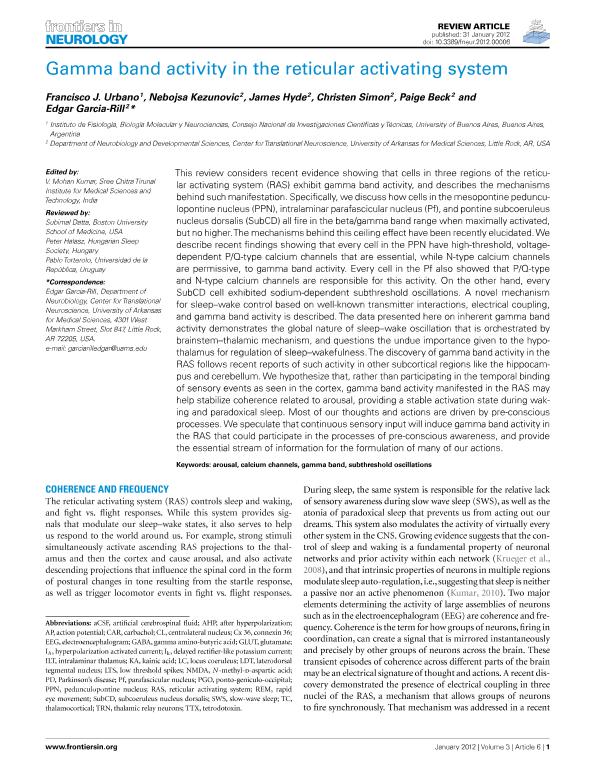Artículo
Gamma band activity in the reticular activating system
Urbano Suarez, Francisco Jose ; Kezunovic, Nebojsa; Hyde, James; Simon, Christen; Beck, Paige; Garcia Rill, Edgar
; Kezunovic, Nebojsa; Hyde, James; Simon, Christen; Beck, Paige; Garcia Rill, Edgar
 ; Kezunovic, Nebojsa; Hyde, James; Simon, Christen; Beck, Paige; Garcia Rill, Edgar
; Kezunovic, Nebojsa; Hyde, James; Simon, Christen; Beck, Paige; Garcia Rill, Edgar
Fecha de publicación:
01/2012
Editorial:
Frontiers Head Office-Online publication
Revista:
Frontiers in Neurology
ISSN:
1664-2295
Idioma:
Inglés
Tipo de recurso:
Artículo publicado
Clasificación temática:
Resumen
This review considers recent evidence showing that cells in three regions of the reticular activating system (RAS) exhibit gamma band activity, and describes the mechanisms behind such manifestation. Specifically, we discuss how cells in the mesopontine pedunculopontine nucleus (PPN), intralaminar parafascicular nucleus (Pf), and pontine subcoeruleus nucleus dorsalis (SubCD) all fire in the beta/gamma band range when maximally activated, but no higher.The mechanisms behind this ceiling effect have been recently elucidated.We describe recent findings showing that every cell in the PPN have high-threshold, voltagedependent P/Q-type calcium channels that are essential, while N-type calcium channels are permissive, to gamma band activity. Every cell in the Pf also showed that P/Q-type and N-type calcium channels are responsible for this activity. On the other hand, every SubCD cell exhibited sodium-dependent subthreshold oscillations. A novel mechanism for sleep–wake control based on well-known transmitter interactions, electrical coupling, and gamma band activity is described. The data presented here on inherent gamma band activity demonstrates the global nature of sleep–wake oscillation that is orchestrated by brainstem–thalamic mechanism, and questions the undue importance given to the hypothalamus for regulation of sleep–wakefulness.The discovery of gamma band activity in the RAS follows recent reports of such activity in other subcortical regions like the hippocampus and cerebellum. We hypothesize that, rather than participating in the temporal binding of sensory events as seen in the cortex, gamma band activity manifested in the RAS may help stabilize coherence related to arousal, providing a stable activation state during waking and paradoxical sleep. Most of our thoughts and actions are driven by pre-conscious processes.We speculate that continuous sensory input will induce gamma band activity in the RAS that could participate in the processes of pre-conscious awareness, and provide the essential stream of information for the formulation of many of our actions.
Archivos asociados
Licencia
Identificadores
Colecciones
Articulos(IFIBYNE)
Articulos de INST.DE FISIOL., BIOL.MOLECULAR Y NEUROCIENCIAS
Articulos de INST.DE FISIOL., BIOL.MOLECULAR Y NEUROCIENCIAS
Citación
Urbano Suarez, Francisco Jose; Kezunovic, Nebojsa; Hyde, James; Simon, Christen; Beck, Paige; et al.; Gamma band activity in the reticular activating system; Frontiers Head Office-Online publication; Frontiers in Neurology; 3; 1-2012; 1-16; 6
Compartir
Altmétricas



